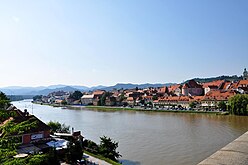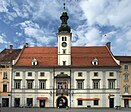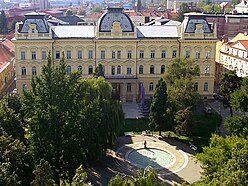
Back Maribor AN ماريبور Arabic ماريبور ARZ Maribor AST Maribor Azerbaijani Марибор Bashkir Marburg an da Drau BAR Марыбар Byelorussian Марыбор BE-X-OLD Марибор Bulgarian
Maribor | |
|---|---|
| Coordinates: 46°33′27″N 15°38′44″E / 46.55750°N 15.64556°E | |
| Country | |
| Traditional region | Styria |
| Statistical region | Drava |
| Municipality | Maribor |
| First mention | 1164 |
| Town privileges | 1254 |
| Government | |
| • Mayor | Saša Arsenovič |
| Area | |
| • City | 40.98 km2 (15.82 sq mi) |
| Elevation | 274.7 m (901.2 ft) |
| Population (2023)[2] | |
| • Urban | 96,209 |
| • Metro | 329,014[1] |
| • City Municipality | 113,000 |
| Demonym(s) | Mariborčan (male), Mariborčanka (female) |
| Time zone | UTC+01 (CET) |
| • Summer (DST) | UTC+02 (CEST) |
| Postal code | 2000 |
| Area code | 02 (+386 2 if calling from abroad) |
| Climate | Cfb |
| Licence plate | MB |
| Website | www |
Maribor (UK: /ˈmærɪbɔːr/ MARR-ib-or, US: /ˈmɑːr-/ MAR-, Slovene: [ˈmáːɾibɔɾ] ; also known by other historical names) is the second-largest city in Slovenia and the largest city of the traditional region of Lower Styria. It is the seat of the Urban Municipality of Maribor and the Drava statistical region. Maribor is also the economic, administrative, educational, and cultural centre of eastern Slovenia.
Maribor was first mentioned as a castle in 1164, as a settlement in 1209, and as a city in 1254. Like most Slovene ethnic territory, Maribor was under Habsburg rule until 1918, when Rudolf Maister and his men secured the city for the State of Slovenes, Croats and Serbs, which then joined the Kingdom of Serbia to form the Kingdom of Yugoslavia. In 1991 Maribor became part of independent Slovenia.
Maribor, along with the Portuguese city of Guimarães, was selected as the European Capital of Culture for 2012.
- ^ "Population on 1 January by five year age group, sex and metropolitan regions". ec.europa.eu. Eurostat. Retrieved 3 June 2024.
- ^ "Prebivalstvo po spolu in po starosti, občine in naselja, Slovenija, letno". stat.si (in Slovenian). Statistical Office of Slovenia. Retrieved 3 June 2024.









